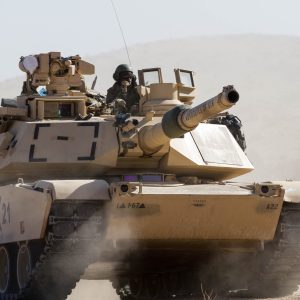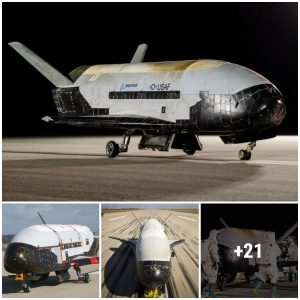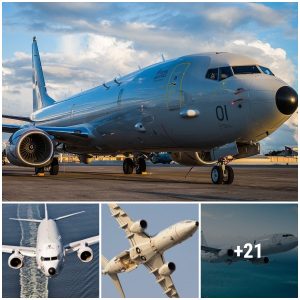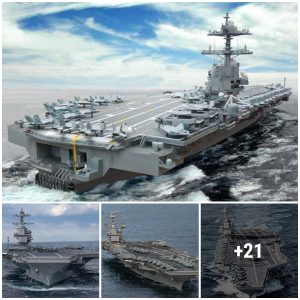Move over, F/A-18 Super Hornet. Sure, the Navy’s mainstay fourth-generation fighter gets most of the screen time in the instant megahit Top Gun: Maverick, but the movie features a nice cameo of the plane behind the plane: the E-2D Advanced Hawkeye airborne early warning aircraft.
As a formation of four Super Hornets led by Capt. Pete Mitchell, call sign Maverick, roars toward a target in enemy territory, the Hawkeye swoops into view, tracking the jets. A naval flight officer in the back of the plane confirms to the fighters that they are on the E-2’s radar. Nothing is going to close on them that the early warning plane won’t spot first.
The ugly Hawkeye

F/A-18 Super Hornets assigned to the Sunliners of Strike Fighter Squadron 81, lead by an E-2C Hawkeye, fly in formation near the Nimitz-class aircraft carrier USS Carl Vinson during a flight demonstration. Carl Vinson is taking part in Southern Seas 2010 as part of a scheduled homeport shift.
With its giant flying saucer-like rotating radar dome, the Hawkeye is an odd-looking and ungainly plane. Designed with collapsible wings for compact storage on the deck of an aircraft carrier, it has twin turboprops and four tails, three of them with working rudders. The rudders exist so the plane can make flat turns, a maneuver that is difficult and stressful to the structure of other aircraft, Eric Beaty, a former Hawkeye naval flight officer (NFO), told Sandboxx. Within the strange exterior, though, is a sophisticated control center capable of providing a 360-degree view of fighters’ surroundings and allowing their pilots to focus on responding to threats and executing their mission.
“The whole reason that airborne radar exists is that the Earth is round,” Beaty said. “And radars do not really broadcast round waves. So those lines in movies about coming in under the radar, that’s real. We put radar in the sky so you can’t come in under it.”

An E-2C Hawkeye assigned to the “Bluetails” Carrier Airborne Early Warning Squadron 121 (VAW-121) executes a high-performance fly-by during an Air Power Demonstration aboard the Nimitz-class aircraft carrier USS George Washington (CVN 73). George Washington Carrier Strike group is currently participating in Partnership of the Americas, a maritime training and readiness deployment of the U.S. Naval Forces with Caribbean and Latin American countries in support of the U.S. Southern Command objectives for enhanced maritime security. (U.S. Navy photo by Airman Joshua Olson)
Beaty, who served in Airborne Command and Control Squadron (VAW)-125, out of Iwakuni, Japan, from 2011 to 2014, said he hasn’t seen the new Top Gun sequel yet. He’s only aware of one other major movie appearance for the Hawkeye: The aircraft was a star in the 1980 film The Final Countdown in which a contemporary aircraft carrier, the USS Nimitz, is transported through time to the day before the attack on Pearl Harbor on Dec. 7, 1941. The carrier’s crew discovers what has happened when an airborne Hawkeye spots Japanese ships moving into position outside the naval base, and the race is on to change the course of history.
Related: The best war movies and shows (according to a Marine machine gunner)
The first to launch and the last to land
For all the capability and versatility of the Hawkeye, most people don’t know how crucial it is to the success of fighter missions. In the carrier air wing, the E-2 is the first to launch from the carrier and the last to land, thanks to its solid fuel economy, compared to fighters, and the value of its “eye in the sky” role.

Five U.S. Navy E-2D Advanced Hawkeyes with Carrier Airborne Early Warning Squadron (VAW) 125, land at Marine Corps Air Station Iwakuni, Japan, Feb. 2, 2017. VAW-125 arrived at MCAS Iwakuni from Naval Station Norfolk, Va. The E-2D Advanced Hawkeye is equipped with the most advanced airborne radar in the world, possessing systems which increase the capabilities to defend Japan and provide security in the Indo-Asia-Pacific region. (U.S. Marine Corps photo by Lance Cpl. Jacob A. Farbo)
“We do almost everything,” Beaty said. “It’s kind of neat. Sometimes you find yourself really having to dig through the manuals on some mission set or some aircraft that you’ve never worked with. Because if the Navy’s providing control, you’re in.”
In addition to controlling fighter missions for Air Force, Navy, and Marine Corps aircraft, Beaty said his squadron had once been tasked with conducting aerial range clearance for a live missile shoot in the Virginia Capes area. Another time, he said, they assisted with keeping a section of maritime space clear of boats and watercraft.
The plane, which has been in service since 1964, has two pilots in the front, and six NFOs in swiveling seats in the back. During flight, the NFOs face the sides of the aircraft so they can monitor their radar screens.

081111-N-9565D-040
PACIFIC OCEAN (Nov. 11, 2008) Lt. Brett Whorley, left, and Lt. Andrew Leatherwood, assigned to Airborne Early Warning Squadron (VAW) 115, the “Liberty Bells”, conduct airborne early warning and strike group coordination from an E-2C Hawkeye between various Carrier Air Wing Five (CVW 5) squadrons assigned to the aircraft carrier USS George Washington (CVN 73). U.S. Navy photo by Mass Communication Specialist 2nd Class Clifford L. H. Davis (Released)
When working with fighters, Beaty said, the idea is not to duplicate efforts, but to multiply processing power and expand response time in order to give U.S. jets a decisive advantage over their adversaries.
“The U.S. government spends a lot of money teaching fighter pilots how to be smart. And we would like them to do that,” he said. “But we provide that extra [situational awareness]… so we’ve got our seven brains against [an adversary’s] one or two. And that’s one of the ways we win.”
The Hawkeye will fly on

200515-N-NC885-1088 Pacific Ocean (May 15, 2020)
An E-2C Hawkeye from the Sun Kings of Carrier Airborne Early Warning Squadron (VAW) 116 prepares to land on the flight deck of the aircraft carrier USS Nimitz (CVN 68) during a composite training unit exercise (COMPTUEX). Nimitz is the flag-ship of the Nimitz Carrier Strike Group (CSG). COMPTUEX is an intensive exercise designed to fully integrate units of the CSG, while testing its ability as a whole to carry out sustained combat operations from the sea. (U.S. Navy photo by Mass Communication Specialist Seaman Apprentice Drace Wilson/RELEASED)
Beaty acknowledged that the Hawkeye comes in for its share of teasing within the carrier air wing – its crew are stereotyped as nerds or oddballs compared with the too-cool-for-school fighter jocks – and its performance is, literally, much less high speed. The E-2 can reach a maximum of 350 knots, or 400 miles per hour, compared with the Super Hornet’s Mach. 1.8, or 1,190 mph. That does have its advantages, though: if there’s a mechanical failure in the Hawkeye, its crew have a thorough working knowledge of the entire Naval Air Training and Operating Procedures Standardization (NATOPS) manual, and a lot more time to respond to a problem than a quick-maneuvering fighter.
And, regardless of how fast the Hawkeye moves, it’s invaluable to the carrier’s air warfare operation.
“We go everywhere the fighters do,” Beaty said. “Hollywood has made a lot of movies with fighter pilots and no controllers. But realistically … if there’s fighters, there’s going to be a controller.”

An E-2C Hawkeye from the “Golden Hawks” of Airborne Early Warning Squadron (VAW) 112 lands aboard the aircraft carrier USS John C. Stennis (CVN 74), marking the Navy’s last air mission in support of Operation New Dawn. John C. Stennis is deployed to the U.S. 5th Fleet area of responsibility conducting maritime security operations.
The Hawkeye might also be more resilient than fighter jets to the march of military modernization. In Top Gun: Maverick, an irritated admiral tells Maverick (Tom Cruise) that the next generation of fighters will be unmanned, and, for all his ace flying skills, he is becoming irrelevant, an artifact of a more analog era. Maverick, of course, does his best to prove the admiral wrong. But if and when manned fighters head to the Boneyard, airborne early warning planes will probably still keep their crews, Beaty said.
“The E-2 is almost certainly going to outlast manned fighters,” he said. “Because the fighters may not need a pilot in them, but someone’s gonna need to tell them what to do. And that will probably be us.”





